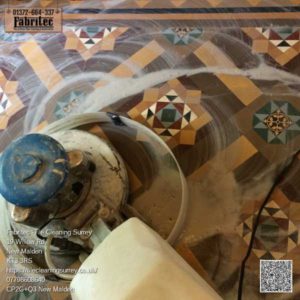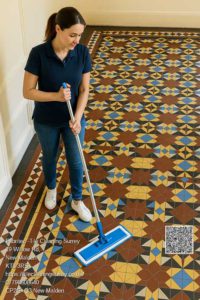Revitalise Your Home with the Classic Restoration of Victorian Hallway Tiles
Victorian hallway tiles are not just flooring elements; they infuse your residence with a sense of timeless elegance that reflects a rich historical narrative. However, these stunning tiles require consistent cleaning and maintenance to maintain their captivating charm. Renowned for their exquisite designs and vivid colours, Victorian tiles were a signature of 19th-century architecture and remain highly sought after in contemporary home décor. Nevertheless, as time progresses, these beautiful tiles face unique challenges that demand a knowledgeable and skilled approach to their upkeep. By giving them the proper care and attention, you can restore their original splendour, ensuring they continue to enhance the unique character of your home.
Exploring the Cultural Importance and Heritage of Victorian Tiles
Victorian tiles are far more than just flooring choices; they are remarkable artifacts that encapsulate a narrative of artistry and craftsmanship from an era long past. Made from robust clay and adorned with stunning designs, these tiles represent a rich legacy that merits preservation. By undertaking the restoration of these historical treasures, homeowners play a crucial role in safeguarding cultural heritage while simultaneously enhancing the value and visual appeal of their homes.
Recognising Common Issues in Neglected Victorian Hallway Tiles
- Loss of Lustre: A common problem encountered with neglected Victorian tiles is the accumulation of wax, a protective coating that many homeowners apply to enhance shine and protect surfaces. Over time, this wax buildup can obscure the tiles, giving them a dull and lifeless appearance. Poorly maintained wax traps dirt and dust, further dulling the brightness and vibrancy of the tiles, complicating the restoration process.
- Surface Imperfections: In the absence of appropriate cleaning and care, scratches and discolouration can degrade the surfaces of Victorian tiles. Often, this deterioration stems from dirt, grit, or the use of harsh cleaning methods that can erode the tile surface. The once vibrant colours and intricate designs may become obscured, leading to unsightly blemishes and a loss of the tiles' original allure.
- Decline of Authentic Beauty: One of the most disheartening outcomes of neglect is the loss of original charm in Victorian tiles. Each tile was crafted with meticulous attention to detail, designed to elevate the room's aesthetic. Over time, neglect can result in faded patterns and washed-out colours, making your space feel outdated and stripped of its historical charm.
Step-by-Step Guide to Effectively Restoring Victorian Tiles

Step 1: Effective Techniques for Wax Removal
The initial step in the restoration journey involves the careful removal of old wax layers using non-abrasive and tile-safe cleaning products that efficiently lift the buildup without causing damage to the underlying surface. This step is essential for rejuvenating the tiles’ natural beauty and ensuring they shine as intended.
Step 2: Comprehensive Deep Cleaning to Restore Vibrancy
A professional deep cleaning process targets stubborn grout lines, enduring stains, and embedded dirt, allowing the tiles to regain their original vibrancy. This critical stage ensures that any discolouration is effectively addressed, restoring the tiles to their former glory and enhancing their visual impact.
Step 3: Implementing Robust Moisture Control Solutions
Older properties frequently lack adequate modern moisture barriers, making moisture control an essential aspect of tile maintenance. We utilise dehumidifiers or breathable sealers to avert future moisture-related issues, ensuring that your tiles remain in prime condition for years to come.
Step 4: Sealing for Enduring Protection
Finally, we apply a breathable impregnating sealer that protects the tiles from moisture and stains, guaranteeing long-lasting durability and preserving their magnificent appearance. This final step is vital for maintaining the quality and longevity of your tiles over time.
Key Maintenance Tips After Restoration
-
1. Opt for pH-Neutral Cleaners for Optimal Care
When cleaning your Victorian tiles, it's paramount to choose suitable cleaning products that will preserve their appearance and safeguard the sealant. pH-neutral cleaners are specifically formulated to gently cleanse surfaces without stripping the sealant or causing any damage to the tiles. These gentle cleaners will not lead to abrasion, discolouration, or fading over time, ensuring your tiles remain beautiful.
Recommended pH-Neutral Cleaners for Victorian Tiles:
- LTP Wash – Ideal for regular cleaning without compromising the integrity of the sealant.
- Fila Multisurface Cleaner – An effective yet gentle solution, perfect for maintaining tile surfaces.
2. Establish a Consistent Cleaning Routine to Prevent Buildup

Even after the tiles have been restored, dirt, dust, and grease can accumulate over time. Establishing a regular cleaning routine is essential to prevent buildup, ensuring that your tiles remain visually appealing. Regularly sweep or vacuum to eliminate dirt and debris, and mop with a damp cloth to keep the tiles clean and gleaming.
- Tip: Use a microfiber mop for gentle yet effective cleaning that won't scratch the tile surface.
3. Avoid Abrasive Tools and Harsh Chemicals
When caring for Victorian tiles, it is crucial to steer clear of abrasive brushes, harsh scrubbers, or chemical cleaners that can harm the sealant or scratch the tile surface. Abrasive tools can leave unsightly marks, dulling the shine and making the tiles more vulnerable to wear and tear.
Items to Avoid When Cleaning:
- Steel wool pads
- Bleach or ammonia-based cleaners
- Abrasive scrubbing brushes
Instead, opt for soft, non-abrasive sponges or cloths to maintain the tiles’ pristine condition.
4. Promptly Address Minor Wear and Tear
Over time, minor wear and tear on your tiles is inevitable, but effective methods exist to address these issues without compromising the overall finish. If you detect small stains or spots that are challenging to remove with regular cleaning, it’s crucial to treat them promptly to prevent further damage.
- Spot Cleaning: For persistent stains, gently rub the affected area with a mild cleaner and a soft cloth.
- Surface Scuffs: Light scuffs can often be buffed out using a microfiber cloth. For more stubborn marks, applying a thin coat of sealer can restore the finish.
Tip: Avoid delaying the cleanup of spills. Staining liquids such as wine, coffee, or oil can set in quickly, making removal significantly more difficult later on.
5. Reapply the Sealer Periodically for Long-Lasting Protection
While the initial restoration includes sealing the tiles, it is advisable to reapply the impregnating sealer every few years, depending on foot traffic and wear. The sealer provides a vital layer of protection against moisture, dirt, and grime, which can otherwise penetrate the tiles and result in damage.
Steps to Apply Sealer Effectively:
- Ensure the surface is thoroughly clean and dry before reapplying the sealer.
- Apply the sealer in thin, even coats, allowing each coat to dry completely before applying the next.
- Pay extra attention to high foot traffic areas to ensure they receive adequate protection.
The Benefits of Investing in Professional Victorian Hallway Tile Cleaning Services
While some homeowners might contemplate DIY restoration, hiring a professional tile restoration service frequently delivers superior outcomes. Professionals possess the necessary equipment, expertise, and knowledge to handle the delicate nature of Victorian tiles, ensuring a successful restoration with minimal risk of damage.
Tile restoration specialists can offer:
- Comprehensive cleaning and restoration services specifically tailored for Victorian tiles.
- Expertise in moisture control and sealing to protect your tiles from future damage.
- Professional guidance on effective long-term maintenance strategies for your tiles.
If you’re considering restoring your Victorian tiles, seeking professional assistance can significantly enhance the overall outcome.
Need Expert Assistance? Engage the Professionals
While DIY cleaning is a feasible option, hiring a professional ensures that no damage is inflicted on the original surface of your tiles.
Frequently Asked Questions About Victorian Hallway Tile Cleaning
What is the Recommended Cleaning Frequency for My Victorian Hallway Tiles?
For optimal upkeep, light cleaning should be conducted weekly, with deep cleaning and resealing every 1–2 years, contingent on levels of foot traffic.
Can I Use Bleach or Vinegar on My Victorian Tiles?
Absolutely not. These substances can erode the tiles and damage the sealant. It is best to stick to using only pH-neutral cleaners.
Is Wax Removal Essential Before Sealing?
Yes, it is crucial to remove wax to ensure that sealers adhere properly and provide lasting protection for your tiles.
Should I Hire a Professional for Tile Restoration Services?
For the best results and to prevent accidental damage, hiring a professional is highly recommended.
The Enduring Appeal and Value of Victorian Hallway Tiles
Victorian hallway tiles are exquisite historical pieces that, with adequate cleaning and maintenance, can retain their breathtaking charm for generations. Whether you are embarking on the restoration of a home in Chertsey or simply looking to refresh your hallway, investing in the care of these unique floors is always a prudent choice.
The Article: Uncover the Shocking Transformation of a Neglected Victorian Hallway In Chertsey first appeared on https://tilecleaningsurrey.co.uk
The Article Victorian Hallway Tiles Cleaning Chertsey: How to Restore & Maintain Timeless Floors first appeared on https://fabritec.org
The Article Victorian Hallway Tiles Cleaning: Restore and Care for Timeless Floors Was Found On https://limitsofstrategy.com

